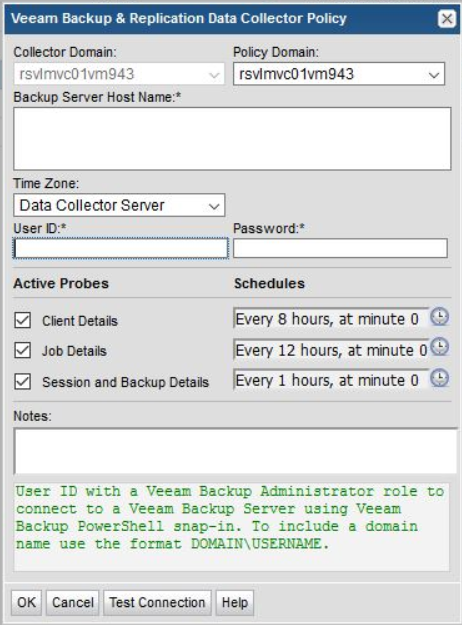

Field | Description |
Collector Domain | The domain of the collector to which the collector backup policy is being added. This is a read-only field. By default, the domain for a new policy will be the same as the domain for the collector. This field is set when you add a collector. |
Policy Domain | The Policy Domain is the domain of the policy that is being configured for the Data Collector. The Policy Domain must be set to the same value as the Collector Domain. The domain identifies the top level of your host group hierarchy. All newly discovered hosts are added to the root host group associated with the Policy Domain. Typically, only one Policy Domain will be available in the drop-down list. If you are a Managed Services Provider, each of your customers will have a unique domain with its own host group hierarchy. To find your Domain name, click your login name and select My Profile from the menu. Your Domain name is displayed in your profile settings. |
Backup Server Host Name* | One or more Veeam Backup Server Host Names to probe. IP Address is not supported. Comma-separated host names are supported. Example, VeeamServer1, VeeamServer2. |
Time Zone | Select the time zone of Veeam Backup Server. By default, the data collector server time zone is used. |
User ID* | User ID with a Veeam Backup Administrator role to connect to a Veeam Backup Server using Veeam Backup PowerShell snap-in. To include a domain name use the format DOMAIN\USERNAME. |
Password* | Password for Veeam Backup Server associated with the User ID. |
Active Probes | |
Client Details | Probe for collecting clients to be backed up using Veeam Backup & Replication. |
Job Details | Probe for collecting jobs scheduled for Veeam Backup & Replication. |
Session and Backup Details | Probe for collecting session details and backups created by Veeam Backup & Replication. |
Schedule | Click the clock icon to create a schedule. By default, it is collected at 4:04 am daily. Every Minute, Hourly, Daily, Weekly, and Monthly schedules may be created. Advanced use of native CRON strings is also available. Examples of CRON expressions: */30 * * * * means every 30 minutes */20 9-18 * * * means every 20 minutes between the hours of 9am and 6pm */10 * * * 1-5 means every 10 minutes Mon - Fri. Note: Explicit schedules set for a Collector policy are relative to the time on the Collector server. Schedules with frequencies are relative to the time that the Data Collector was restarted. |
Test Connection | Test Connection initiates a Data Collector process that attempts to connect to the subsystem using the IP addresses and credentials supplied in the policy. This validation process returns either a success message or a list of specific connection errors. Test Connection requires that Agent Services are running. Several factors affect the response time of the validation request, causing some requests to take longer than others. For example, there could be a delay when connecting to the subsystem. Likewise, there could be a delay when getting the response, due to other processing threads running on the Data Collector. You can also test the collection of data using the Run functionality available in Admin>Data Collection>Collector Administration. This On-Demand data collection run initiates a high-level check of the installation at the individual policy level, including a check for the domain, host group, URL, Data Collector policy and database connectivity. You can also select individual probes and servers to test the collection run. See
Working with On-Demand Data Collection for details. |